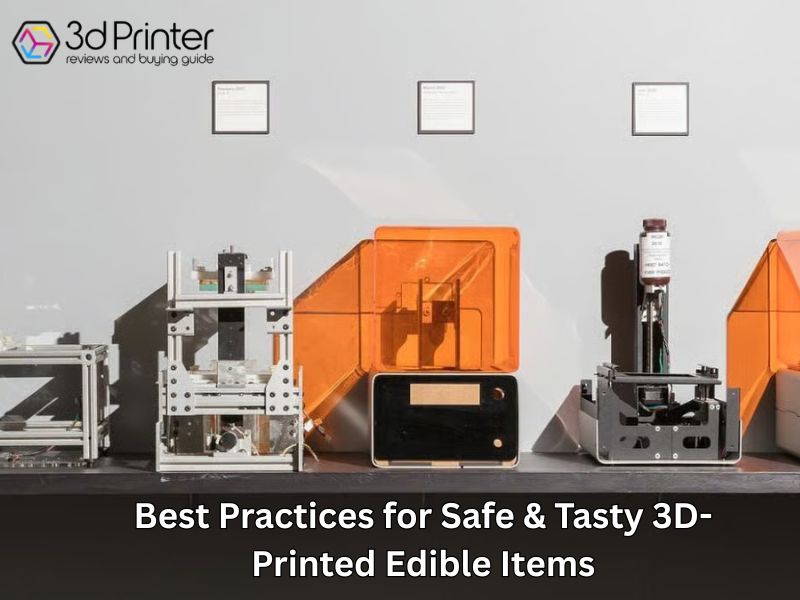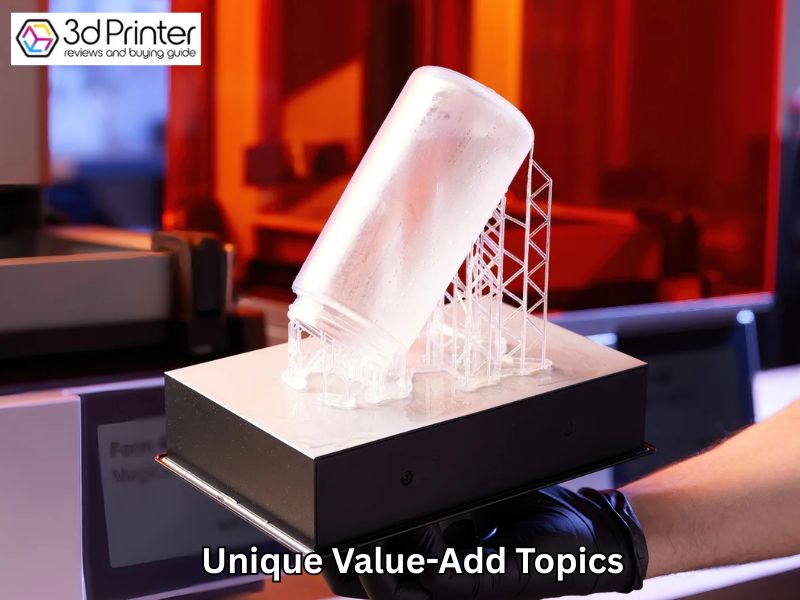Introduction to 3D Printer Edible Filament and Its Benefits
What is edible filament for 3D printing?
Edible filament is a food-safe material made from ingredients like chocolate, sugar, or dough. It works with specially designed food machines to create custom treats. Instead of plastic, a 3d printer uses food paste to build tasty shapes, layer by layer.
You can print candies, cookies, or even pasta using these filaments. Each design is safe to eat and can be customized for taste, texture, or looks.
Why hobbyists and businesses in the USA want food-safe printable materials
Home users love the fun of printing personalized sweets. It’s perfect for birthdays, holidays, or creative kitchen projects.
For small businesses, 3D printer edible filament offers a unique way to stand out. They can print custom logos on candy or create one-of-a-kind food items for customers.
Many people in the USA also look for food that fits their diet. Edible printing helps control ingredients and avoid allergens. Some even use it to boost nutrition with added vitamins or protein. If you’re exploring this for your business, check out the best 3D printer for small business to get reliable results with food-safe features.
Plus, it supports eco-friendly goals. Instead of wasting food, leftovers can be turned into printable paste for fun, tasty shapes.

Understanding Food-Grade Filaments: Safety & Taste
Types of Food-Safe 3D Printing Filament: PLA, PETG, PP, TPU, and Nylon
PLA (Polylactic Acid) is made from natural sources like corn or sugar. It’s biodegradable and generally safe for food contact if it’s pure and free of additives. However, many colored or mixed PLA filaments aren’t food-safe. Also, PLA softens at low temperatures, so it’s not great for hot foods or dishwasher use.
PETG is popular for food-safe printing because it’s strong and can withstand higher temperatures than PLA. It’s the same material used in many plastic water bottles. But only PETG filaments labeled as FDA-compliant are truly safe for food, so it’s essential to check the label.
Polypropylene (PP) is flexible and chemically resistant. It’s commonly used in food containers and can withstand higher temperatures, making it dishwasher safe. Printing with PP is trickier because it can warp, so you need the correct printer settings. Only certified food-safe PP should be used for edible prints.
TPU and Nylon are great if you want flexible or heat-resistant prints. TPU is stretchy and suitable for parts that need to bend, while Nylon is strong and durable. These filaments are less commonly certified food-safe, so check carefully before using them for edible designs.
FDA Approval and Regulatory Standards for Edible Filament
When a filament is labeled “FDA-compliant,” it means the material meets FDA standards for food contact. This ensures it won’t release harmful substances into food. But there’s a difference between transient contact and long-term use certification.
Transient contact means the filament is safe for brief contact with food, like cookie cutters or molds. These items don’t hold food for long, so the safety standards are less strict.
Long-term use means the printed item can safely hold food or liquids for extended periods, like cups or utensils. This requires stricter safety checks and durability tests.
Always check if your filament’s FDA compliance fits the kind of edible printing you want to do.
Common Challenges When Printing With Edible Filament
Porosity and Layer Lines That Can Trap Bacteria
Why Rough Surfaces Need Sealing
When using 3D printer edible filament to print edible items, the surface often has tiny gaps and visible layer lines. These little crevices can easily trap bacteria. Even if the filament is food-safe, these rough surfaces create spots where germs can grow. That’s why sealing the print is important. A smooth, sealed surface helps keep your edible creations safer and cleaner for eating.
How Print Structure Affects Food Safety
The way you print also matters. If your design has low infill or thick layers, it leaves more empty spaces inside. These spaces can hold moisture and bacteria, which can compromise food safety. Printing with higher infill and thinner layers reduces these gaps but doesn’t remove them completely. So, sealing and proper cleaning are essential steps when working with 3D printer edible filament to make sure your edible prints are safe to eat.
Contaminants in Nozzles and Extruder Paths
Risks from Brass Nozzles and Prior Filament Residue
Most 3D printers come with brass nozzles. These can contain tiny amounts of metals like lead, which aren’t safe for food contact. Also, if you print with non-food-safe filaments and then switch to 3d printer edible filament without cleaning, leftover material can contaminate your edible print. This cross-contamination can be harmful if ingested.
Best Practice: Using Dedicated Stainless-Steel Nozzles
To avoid these risks, it’s best to use a stainless-steel nozzle dedicated only to 3D printer edible filament printing. Stainless steel is safer because it doesn’t contain harmful metals and resists corrosion. Plus, keeping your printer clean and avoiding mixing different filament types helps make sure your edible designs stay safe and tasty.

Best Practices for Safe & Tasty 3D-Printed Edible Items
Choosing the Right Food-Safe Filament for Your 3D Prints
When you pick a filament for edible 3D printing, safety should always come first. Look for filaments that clearly state they are food-safe. Avoid those with extra additives or artificial colorants, as they can be harmful if they come into contact with food.
A smart way to confirm is by checking the manufacturer’s Material Safety Data Sheet (MSDS) or any certification they provide. When choosing 3d printer edible filament, look for filaments that meet FDA standards or similar regulations. This gives you extra peace of mind knowing the material is tested and approved for food contact.
Cleaning and Post-Processing to Keep Your Prints Safe and Delicious
After printing, it’s important to clean your edible creations properly. Before cleaning, make sure to level a 3D printer bed correctly to ensure smooth prints with fewer imperfections. Then wash them gently with warm water and a mild detergent around 120°F (about 49°C). This helps remove any leftover residues without damaging your design.
To make your printed food even safer, consider applying a food-grade coating or sealant to your 3d printer edible filament creations. This smooths out the surface and prevents bacteria from hiding in tiny grooves or rough spots. It’s a simple step that improves both safety and appearance.
Setting Up Your 3D Printer for Edible Filament Printing
To avoid contamination, use a dedicated 3D printer or at least a dedicated nozzle for edible filament projects. Stainless steel nozzles are the best choice because they don’t contain harmful metals like brass nozzles might.
Store your 3d printer edible filament carefully in airtight containers with desiccants to keep moisture and dust away. Proper storage keeps your filament fresh and prevents any unwanted contaminants that could affect the taste or safety of your prints.
Designing With Edible Filament: Creative & Culinary Ideas
Simple to Complex Edible Creations
3D printing with edible filament lets you craft fun and unique treats. You can create candy shapes, custom gummies, and even cookie dough models with ease. These designs can be as simple or detailed as you want. For example, making personalized gummy bars or edible logos adds a creative touch to sweets. Some innovators even print chocolate using food-safe tubing, allowing detailed chocolate designs that taste great.
Bake-After-Print Designs: Cookies and Dough-Based Items
You can also use 3D printing to shape dough before baking it. This method helps create cookies and other baked goods with unique shapes and textures. By adjusting infill patterns inside the printed dough, you control how crispy or soft the final product becomes. This technique opens new possibilities for tasty, custom-baked treats.
Emerging Innovations Beyond Traditional Edible Filament
Antimicrobial Peanut-Hull PLA Filament (PLA-AHL)
Researchers have created a new type of 3d printer edible filament by adding peanut hull powder to PLA plastic. This mix helps reduce bacteria growth on printed food items. The peanut hulls bring natural antimicrobial qualities that make the prints safer and more hygienic. While this blend improves strength and flexibility, it can also create tiny pores in the material. Despite this, the 3d printer edible filament remains safe and biocompatible, making it ideal for food-related 3D printing projects where cleanliness matters.
Infusion of Functional Ingredients for Nutrition Enhancement
Another exciting development is adding vitamins, antioxidants, and proteins directly into printable dough. This means you can create 3D-printed snacks that are not just tasty but also boost nutrition. For example, cookies printed with added antioxidants can support health while offering custom flavors and shapes. This approach opens new doors for personalized snacks tailored to specific dietary needs or health goals.
Business Uses & DIY Applications in the USA
Custom Edible Brand Merchandise and Promotional Designs
Businesses in the USA are using 3D printed edible filament to create unique and memorable brand merchandise. By printing custom edible logos, sample chocolates, and giveaways, companies can make a strong impression at events and trade shows. These edible products grab attention and help brands stand out.
Benefits for Businesses:
- Brand Visibility: Custom edible items with logos or slogans make giveaways more eye-catching and memorable.
- Customer Engagement: Offering personalized edible treats creates a fun and interactive experience for customers.
- Social Media Appeal: Unique and tasty designs are often shared online, boosting brand exposure.
This approach helps businesses connect with their audience in fresh, creative ways that also showcase their products or services.
Niche Markets: Diet-Tailored Prints and Allergen-Free Options
3D printed edible filament opens doors to niche markets by letting businesses make food products tailored to specific dietary needs.
Diet-Tailored Prints:
- Personalized Nutrition: Companies can create nutrition bars or snacks designed for individual health needs, adjusting ingredients and nutrients.
- Health-Conscious Consumers: These options appeal to people who want snacks that fit their unique diet plans.
Allergen-Free Options:
- Vegan and Gluten-Free Products: 3D printing allows the making of edible items that suit vegan and gluten-free diets.
- Allergen-Safe Gummies: Businesses can offer allergen-free gummy treats, helping customers with food sensitivities feel safe.
This customization makes 3D-printed edible products an excellent choice for consumers with special dietary requirements.

Two Unique Value-Add Topics Missing in Most Articles
Hygienic Design Tips for Printable Food Objects
When printing edible items, design matters a lot for safety. Food-safe filament alone isn’t enough. You need to think about how easy it will be to clean your printed objects when using 3d printer edible filament.
Design seamless, low-crevice prints: Choose smooth shapes without tiny gaps or hard-to-reach corners. These crevices can trap food bits and germs. Rounded edges help too, because sharp corners hold bacteria more easily.
Pick the right geometry and infill: A solid or dense fill inside the print reduces hollow spaces where bacteria might hide. Patterns like grid or cubic infill offer strength and fewer gaps. The thicker your print, the safer it will be to eat.
This approach helps you make 3D-printed food items that stay clean and safe for longer.
Shelf-Life and Storage Guidance for Edible Printed Products
How long your edible prints stay fresh depends on what they’re made of and how you store them.
Freshness depends on materials and moisture: Sugary or dough-based filaments spoil faster if left out. High moisture content means shorter shelf life. Most edible prints should be eaten within a few days unless properly stored.
Keep your prints fresh with proper packaging and refrigeration: Use airtight containers or vacuum-seal your items to keep out air and moisture. Refrigerate perishable prints to slow spoilage, but avoid freezing since that can change texture and taste. When storing items made with 3d printer edible filament, label your packages with the print date to track freshness effectively.
Frequently Asked Questions
1. What is food-safe filament for 3D printing?
Food-safe filament is made without harmful chemicals and can safely touch food. PLA and PETG are the most common options.
2. Is PLA safe for printing edible items?
Yes, pure PLA is safe for short food contact. But avoid colored or filled versions unless labeled food-safe.
3. Do I need a special nozzle for edible printing?
Yes. Use a stainless-steel nozzle and keep it separate from regular printing to prevent contamination.
4. Why do I need to seal edible prints?
FDM prints have tiny gaps that can hold bacteria. Sealing makes the surface smooth and safer for food use.
5. Can bacteria grow on 3D-printed food items?
Yes. Moisture and gaps can trap germs. Clean thoroughly and coat the print if needed.
6. How do I clean edible 3D prints?
Wash with warm water and mild soap. Avoid dishwashers—they may warp the print.
Conclusion & Key Tips for Safe, Tasty Edible 3D Printing
To print safe and tasty edible items, always start with FDA-compliant food-safe filaments like PLA or PETG. Avoid cheap materials with unknown additives. Use a dedicated 3D printer or at least a stainless-steel nozzle to prevent contamination.
Design your models with smooth surfaces and simple shapes. This makes them easier to clean and reduces the risk of bacterial risks. Choose a high infill density to avoid gaps where germs can hide.
After printing, wash thoroughly with warm water and food-safe soap. Add a food-safe coating for extra protection and smoother texture.
If you want to get creative, try edible prints like custom chocolate molds, cookie cutters, or gummy shapes. You can even explore nutrient-rich doughs for healthy snack designs.
Stay safe, keep it clean, and don’t be afraid to have fun with your edible 3D printing ideas!
Relevant Articles
- Top Upgrades for Anycubic Kobra 2 Max
- Anycubic Kobra 2 Plus Review and Features
- Complete Guide to Using Lithophane Generator
- How to Use 3D Printer: Step-by-Step Guide
- How to Use Blender for 3D Printing Beginners’ Guide
- DIY Filament Maker: Make Your Own 3D Printer Filament
- Why Do My 3D Prints Keep Failing? Troubleshooting Tips
- How to Print Using 3D Printer: Beginner’s Tutorial
- How to Use Ender 3D Printer: Tips and Tricks
- How to Use a 3D Printer for Beginners: Easy Guide
- Fusion 360 by Autodesk: Full Overview for 3D Printing
- How to Use Fusion 360 for 3D Printing: Complete Guide
